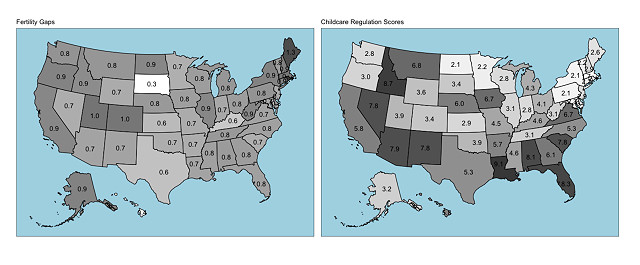Highlights
- We find that less child care regulation, represented by a higher “freedom” index score, is associated with a lower fertility gap. Post This
- A new working paper from Clara Piano, Lyman Stone, et al., studies the relationship between child care regulatory intensity and variation in fertility gaps in the U.S. Post This
- If the state with the lowest child care regulatory score (i.e., Connecticut) obtained the same score as the state with the best regulatory score (i.e., Louisiana), the fertility gap would fall by close to 0.2 children. Post This
Welcoming a child into the world is an experience many men and women dream about. For husbands and wives in “family-first marriages,” as Brad Wilcox terms them, children are a major part of the couple’s vision for the future. They may discuss an ideal family size, a measure that informs the “fertility gap” between desired and actual fertility. When dreams of family become reality, though, the “ideal” is met with a swath of unexpected costs demanding to be addressed (see Catherine Pakaluk’s recent work for a compelling glimpse of the unexpected benefits). At the top of the list of new adjustments is how parents will allocate their time to incorporate care for their little one.
Child care is a headache, but notably, parents in different parts of the country experience the child care market very differently, and this can affect their family decisions. In a new working paper, Clara Piano, Lyman Stone, Vincent Geloso, and I study the relationship between child care regulatory intensity and variation in fertility gaps across the Unites States. Below is a map of the fertility gap and a map of child care freedom index scores, which are higher when there is less stringent regulation on licensed child care arrangements. The pervasive existence of fertility gaps is striking—0.3 “children” is the lowest gap and 1.3 is the highest. The images suggest an inverse relationship between the two values, which is confirmed by our statistical estimation.
Figure 1: Fertility Gaps and Child Care Regulations Across the U.S.
Source: Anna Clare Flowers, Vincent Geloso, Clara Piano, and Lyman Stone "Child care
Regulation and the Fertility Gap" SSRN, May 20, 2024.
We find that less child care regulation, represented by a higher “freedom” index score, is associated with a lower fertility gap. To isolate the effect of child care regulations, we include each state’s average household income, share of married adults, share of foreign-born adults, share of adults who identify as religiously unaffiliated, as well as parental time-use data to estimate the gendered share of child care as identified by the sex of the respondent. All of these have been shown to impact fertility.
A full analysis can be found in the working paper, but the economic significance of the results is as follows. If the state with the lowest regulatory score (i.e., Connecticut) obtained the same score as the state with the best regulatory score (i.e., Louisiana), the gap would fall by close to 0.2 children. In Connecticut, where the total fertility rate stood at 1.51, this figure would rise to slightly above 1.70—an increase of 13%.
Child care is one of the highly regulated industries captured in the economic freedom index with intensity varying significantly across states. Though employee education minimums, annual training hours, child-staff ratios, and group size requirements are intended to uphold safety and quality for children, research exploring the unintended consequences of these efforts reveals many of the regulations are not effective or appropriate for their desired ends. Further, all of them play a part in increasing the price of child care services.
In addition to affordability, child care freedom allows for more flexible arrangements and a wider variety of options. This aides couples seeking to establish work-family compatibility regardless of their career fields. Our results are intuitive because parents who are on waiting lists for day care, for example, or who cannot afford to hire help, are more likely to postpone having children.
Research on economic freedom and the fertility gap has prompted further investigation into regulations, work-life compatibility, and family decisions. Identifying a relationship between regulatory constraints on child care and the ability of families to grow as desired supports the idea that promoting economic freedom, especially in highly relevant industries, is a family-friendly agenda worth pursuing.
Anna Claire Flowers is a PhD Fellow with the Mercatus Center and a Graduate Fellow with the F.A. Hayek Program for Advanced Study in Philosophy, Politics, and Economics.













